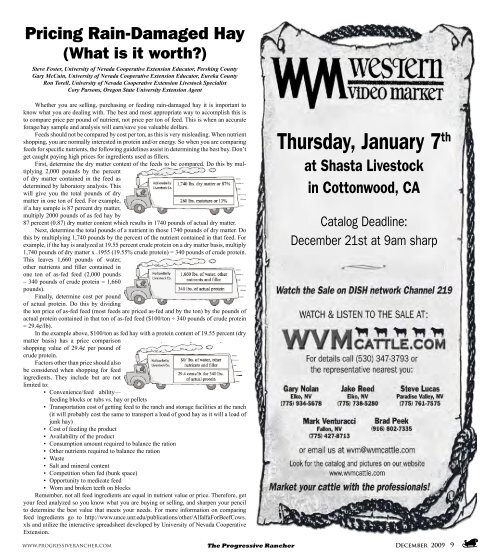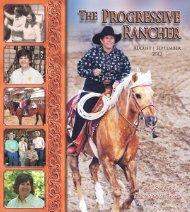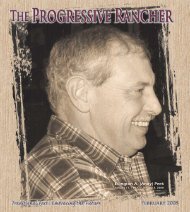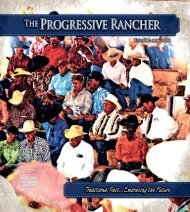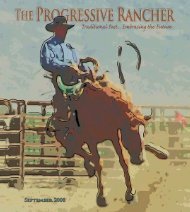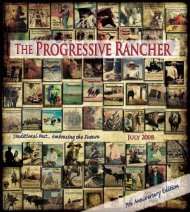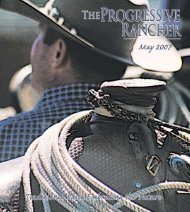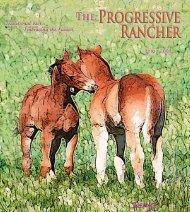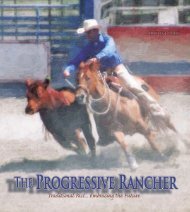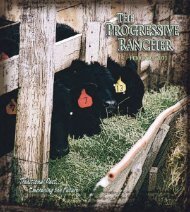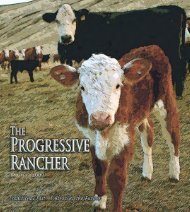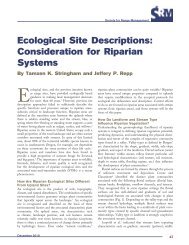The Progressive Rancher Magazine
The Progressive Rancher Magazine
The Progressive Rancher Magazine
Create successful ePaper yourself
Turn your PDF publications into a flip-book with our unique Google optimized e-Paper software.
Pricing Rain-Damaged Hay<br />
(What is it worth?)<br />
Steve Foster, University of Nevada Cooperative Extension Educator, Pershing County<br />
Gary McCuin, University of Nevada Cooperative Extension Educator, Eureka County<br />
Ron Torell, University of Nevada Cooperative Extension Livestock Specialist<br />
Cory Parsons, Oregon State University Extension Agent<br />
Whether you are selling, purchasing or feeding rain-damaged hay it is important to<br />
know what you are dealing with. <strong>The</strong> best and most appropriate way to accomplish this is<br />
to compare price per pound of nutrient, not price per ton of feed. This is when an accurate<br />
forage/hay sample and analysis will earn/save you valuable dollars.<br />
Feeds should not be compared by cost per ton, as this is very misleading. When nutrient<br />
shopping, you are normally interested in protein and/or energy. So when you are comparing<br />
feeds for specific nutrients, the following guidelines assist in determining the best buy. Don’t<br />
get caught paying high prices for ingredients used as fillers.<br />
First, determine the dry matter content of the feeds to be compared. Do this by multiplying<br />
2,000 pounds by the percent<br />
of dry matter contained in the feed as<br />
determined by laboratory analysis. This<br />
will give you the total pounds of dry<br />
matter in one ton of feed. For example,<br />
if a hay sample is 87 percent dry matter,<br />
multiply 2000 pounds of as fed hay by<br />
87 percent (0.87) dry matter content which results in 1740 pounds of actual dry matter.<br />
Next, determine the total pounds of a nutrient in those 1740 pounds of dry matter. Do<br />
this by multiplying 1,740 pounds by the percent of the nutrient contained in that feed. For<br />
example, if the hay is analyzed at 19.55 percent crude protein on a dry matter basis, multiply<br />
1,740 pounds of dry matter x .1955 (19.55% crude protein) = 340 pounds of crude protein.<br />
This leaves 1,660 pounds of water,<br />
other nutrients and filler contained in<br />
one ton of as-fed feed (2,000 pounds<br />
– 340 pounds of crude protein = 1,660<br />
pounds).<br />
Finally, determine cost per pound<br />
of actual protein. Do this by dividing<br />
the ton price of as-fed feed (most feeds are priced as-fed and by the ton) by the pounds of<br />
actual protein contained in that ton of as-fed feed ($100/ton ÷ 340 pounds of crude protein<br />
= 29.4¢/lb).<br />
In the example above, $100/ton as fed hay with a protein content of 19.55 percent (dry<br />
matter basis) has a price comparison<br />
shopping value of 29.4¢ per pound of<br />
crude protein.<br />
Factors other than price should also<br />
be considered when shopping for feed<br />
ingredients. <strong>The</strong>y include but are not<br />
limited to:<br />
• Convenience/feed ability—<br />
feeding blocks or tubs vs. hay or pellets<br />
• Transportation cost of getting feed to the ranch and storage facilities at the ranch<br />
(it will probably cost the same to transport a load of good hay as it will a load of<br />
junk hay)<br />
• Cost of feeding the product<br />
• Availability of the product<br />
• Consumption amount required to balance the ration<br />
• Other nutrients required to balance the ration<br />
• Waste<br />
• Salt and mineral content<br />
• Competition when fed (bunk space)<br />
• Opportunity to medicate feed<br />
• Worn and broken teeth on blocks<br />
Remember, not all feed ingredients are equal in nutrient value or price. <strong>The</strong>refore, get<br />
your feed analyzed so you know what you are buying or selling, and sharpen your pencil<br />
to determine the best value that meets your needs. For more information on comparing<br />
feed ingredients go to http://www.unce.unr.edu/publications/other/AlfalfaForBeefCows.<br />
xls and utilize the interactive spreadsheet developed by University of Nevada Cooperative<br />
Extension.<br />
Thursday, January 7 th<br />
at Shasta Livestock<br />
in Cottonwood, CA<br />
Catalog Deadline:<br />
December 21st at 9am sharp<br />
www.progressiverancher.com<br />
<strong>The</strong> <strong>Progressive</strong> <strong>Rancher</strong> December 2009 9


